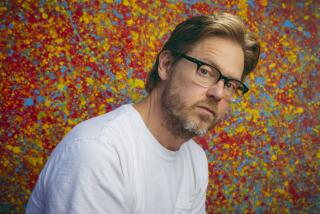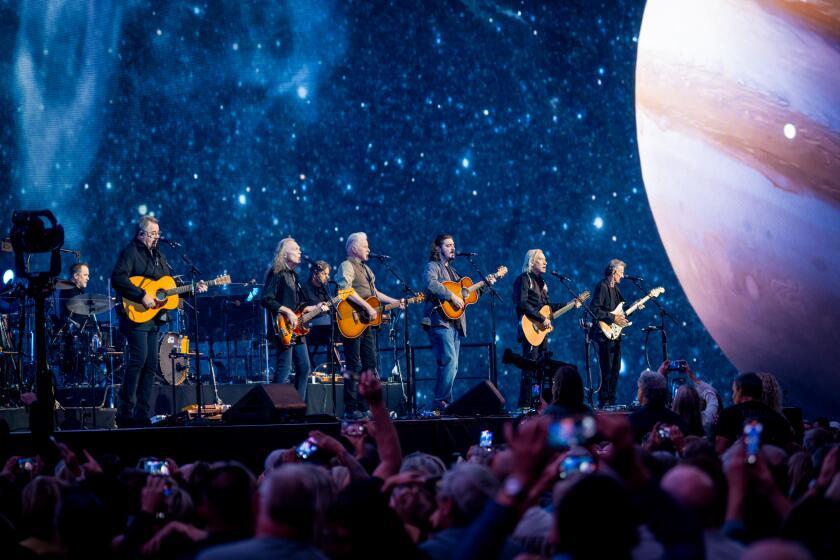Dave Sitek calls on the community to make ‘Maximum Balloon’
Dave Sitek moved to California because of a grapefruit.
The guitarist and resident sound sculptor of New York’s TV on the Radio tells the story this way: In 2008, he was standing backstage at the Treasure Island Music Festival near San Francisco. “This was right before the economy bottomed out, and I’d been looking for a new place in New York,” Sitek says, adding that the rent on his Brooklyn studio, Stay Gold, had grown prohibitively expensive.
So when he bit into a particularly juicy piece of catering-tent fruit — “easily the best I’d ever had” — the plan seemed to present itself: He sought out a cool-looking house in Los Angeles on Craigslist and made a call to his future landlord.
“We finished tour in New York, I flew out here, signed the lease, flew back to New York, went to Europe, got back, and within 24 hours I’d packed up my entire place into a truck with my brothers and drove out here,” Sitek says. Wow. “Yeah, there’s no middle ground with me.”
That claim is borne out on “Maximum Balloon,” a new solo album from Sitek on which he migrates assuredly from TV on the Radio’s woozy art rock to a sleek brand of beat-driven pop. Released Tuesday, the disc features guest appearances by David Byrne, Holly Miranda and Karen O of the Yeah Yeah Yeahs, among others; Sitek was set to celebrate its release with a DJ set Tuesday night at Cinespace in Hollywood.
“Dave’s had a love affair with drum machines and synths since the very beginning of TV on the Radio,” says Karen O, whose band’s three full-lengths were all co-produced by Sitek. “He’s been wielding those instruments experimentally for a while, and now he’s focusing them where they’re most at home — on the dance floor for our dancing pleasure.”
Sitek recorded much of “Maximum Balloon” at his funky Benedict Canyon hideaway, laying down parts in the makeshift studio that occupies one of the ground-floor bedrooms. Music gear trails out of the studio into the living room, where a wall of enormous speakers Sitek refers to as “the lease breakers” stands. The speakers made the move with him from New York; they’re what he listens to his work through before declaring mission accomplished.
“I just thought it’d be fun to make dance tracks and get my friends to sing on them,” he says of the solo set, which, according to Sitek, signals nothing about the end of TV on the Radio. (The same goes for his recent relocation: “As a band, we’ve probably practiced together in a room 20 times in eight years,” he figures.) “It wasn’t really an album until I was five songs deep. Then I was, like, ‘Maybe I should do something with this.’ I played it for [TV on the Radio’s label] Interscope, and they said, ‘Oh, we’d definitely get behind this.’” Sitek laughs. “I was kind of shocked.”
“The chord progressions and the rhythmic structures are very commercial,” says Luke Wood, chief strategy officer at Interscope/Geffen/A&M. “It’s a community-minded record — Dave didn’t work with pop songwriters or get Bruno Mars on a track. But it shows a real commercial sensibility, and that’s what I’m hoping people pick up on.”
So is Sitek, to some degree: In addition to fresh grapefruit, the prospect of doing more production work is part of what drew him to L.A. In 2008 he oversaw an album of Tom Waits covers by Scarlett Johansson, and last year he contributed a track to the rapper Wale’s “Attention Deficit.”
“A lot of the labels are out here, so you can have the suits come in and tell you to make the choruses shorter,” he says with a raspy chuckle. “And you can get weed at the store, which for a lot of people I work with is a benefit.”
Sitek is involved with several projects he says he can’t talk about, except to acknowledge that they might surprise listeners familiar with his more indie-identified output. At his home he plays a handful of unfinished instrumental tracks from his laptop; indeed, with its thudding disco beats and exaggerated bass lines, the music comes closer to ‘80s-era Madonna than to TV on the Radio.
Like many in his position, Sitek insists that everything he does comes from the same creative place, regardless of how it’s categorized.
“I don’t think Dave sees artists as ‘emerging’ or ‘breaking through’ or ‘mainstream,’” says Johansson. “He’s either into the collaboration or it’s not his thing.”
Still, Sitek admits that his journey so far into the world of pop has been an eye-opening one. “You could be thinking that your stuff’s coming out on a record until the last moment, and then some A&R guy crashes his Sebring convertible,” he says. “It’s hard to get emotionally attached to something where nine people are deciding its fate.”
Why bother, then?
“Pop belonged to more musical people in earlier times, but we’ve sort of gotten away from that,” he says. “Now it’s software people. I kind of feel like reclaiming it is in order.”
Sitek’s master plan is that the ailing record industry will turn to him out of sheer desperation in the hopes that he “accidentally gets things right.”
Of course, he adds, “there’s zero sales evidence that it’s going to work. My records don’t go platinum or gold.” Another raspy chuckle. “I think they go cedar.”
calendar@latimes.com
More to Read
The biggest entertainment stories
Get our big stories about Hollywood, film, television, music, arts, culture and more right in your inbox as soon as they publish.
You may occasionally receive promotional content from the Los Angeles Times.











